
The Mayor’s Office of Resiliency and Recovery is demanding a bigger chunk of the funding the state is doling out from FEMA’s Hazard Mitigation Grant Program in order to help pay for a massive Downtown storm-protection project.
BY COLIN MIXSON
The city is calling on Albany to hand over at least another $100 million in federal storm resiliency funding to help protect Lower Manhattan, though even that much isn’t enough to shore up the area against future storms.
Governor Cuomo’s office is currently doling out funds as part of FEMA’s Hazard Mitigation Grant Program, and reps for the Mayor’s Office of Resiliency and Recovery say the city hasn’t been assured an appropriate slice of the pie.
“We believe we deserve more and that we haven’t gotten our fair share,” Michael Shaikh, deputy director of external affairs for the mayor’s recovery team, said at a Community Board 1 meeting on May 17.
The city is at this point requesting around $100 million specifically for Manhattan south of the Brooklyn Bridge — a number based on a calculation of the percent of the overall damage in the state that the city sustained and the total sum of HMGP money provided by the feds, Shaikh said.
“The funds are based on a calculation of Sandy-related damage,” said Shaikh. “New York City suffered [70] percent of all Sandy damage in New York State, but has only gotten a fraction of those HMGP funds, and we’re now asking Albany to send those funds to us.”
But even an additional $100 million won’t be enough to fully fund the resiliency projects needed to protect Downtown Manhattan and local leaders say the funding should be allocated not just base on the proportional damage suffered, but rather on what will be needed to safeguard an area of critical local, state, and nation-wide importance.
“Lower Manhattan is of importance to the city, state, and country,” said Catherine McVay Hughes, chairwoman of Community Board 1. “They should be asking for what’s needed to cover adequate protection for the Manhattan tip.”
Shaikh assured board members that the $100 million figure is not set in stone, and that the city is asking for “at least” that amount.
As part of its application for a recovery grant offered by the U.S. Department of Housing and Urban Development, the city compiled a cost estimate of $234 million for various projects it deemed necessary to protect Lower Manhattan.
So even though the city has already earmarked $100 million in local funding for Manhattan Tip, even an additional $100 million from the state will still leave a shortfall of $34 million.
And locals are concerned even the $234-million estimate may lowball Lower Manhattan’s actual resiliency needs.
“This was just what they put in for the [grant] application, and that was before the scope of the area was extended up through Battery Park City and parts of Tribeca,” said Hughes. “It is not known exactly what the cost is for the Manhattan tip.”
Shaikh countered that, in his experience, the city’s cost estimates tend to overshoot the actual pricetag of a given project. Board members were skeptical, however, saying that Shaikh’s experience ran counter to their own.
“In my over two decades on the community board, I have never seen the city get an estimate that is less than what they expected to spend, with all due respect,” said CB1 member Paul Hovitz.
Just how much money is required to protect Downtown from the next superstorm, and exactly where that funding will come from may remain up in the air, but the city nonetheless intends to move forward with the Lower Manhattan resiliency project’s initial phases, according to the mayor’s office, in essence treating the project as though it is already fully funded, while pursuing the means of making it so.
“Even as we aggressively source additional dollars, we are already moving forward with community engagement and design, so that we can get these new flood protection measures in place as quickly as possible with the funds we have, while also identifying any remaining needs,” said a spokesman for the mayor’s office.


































